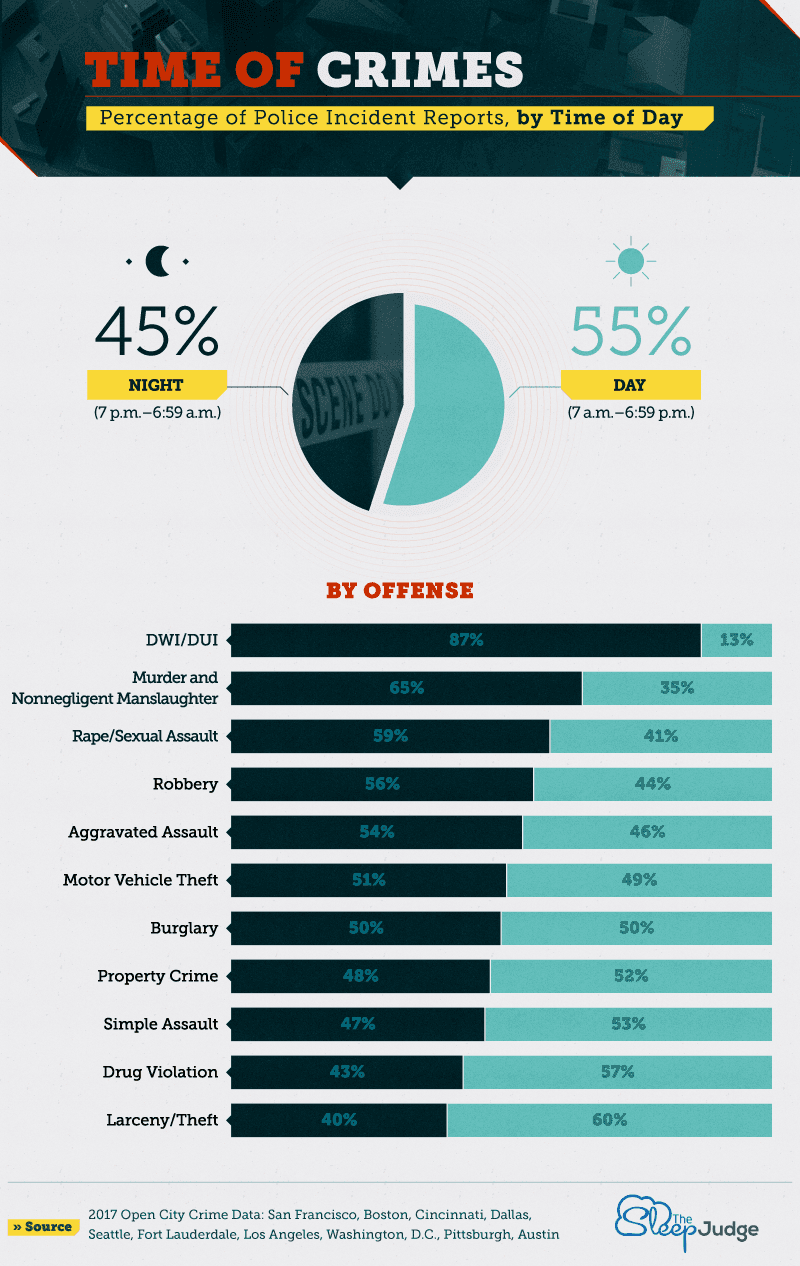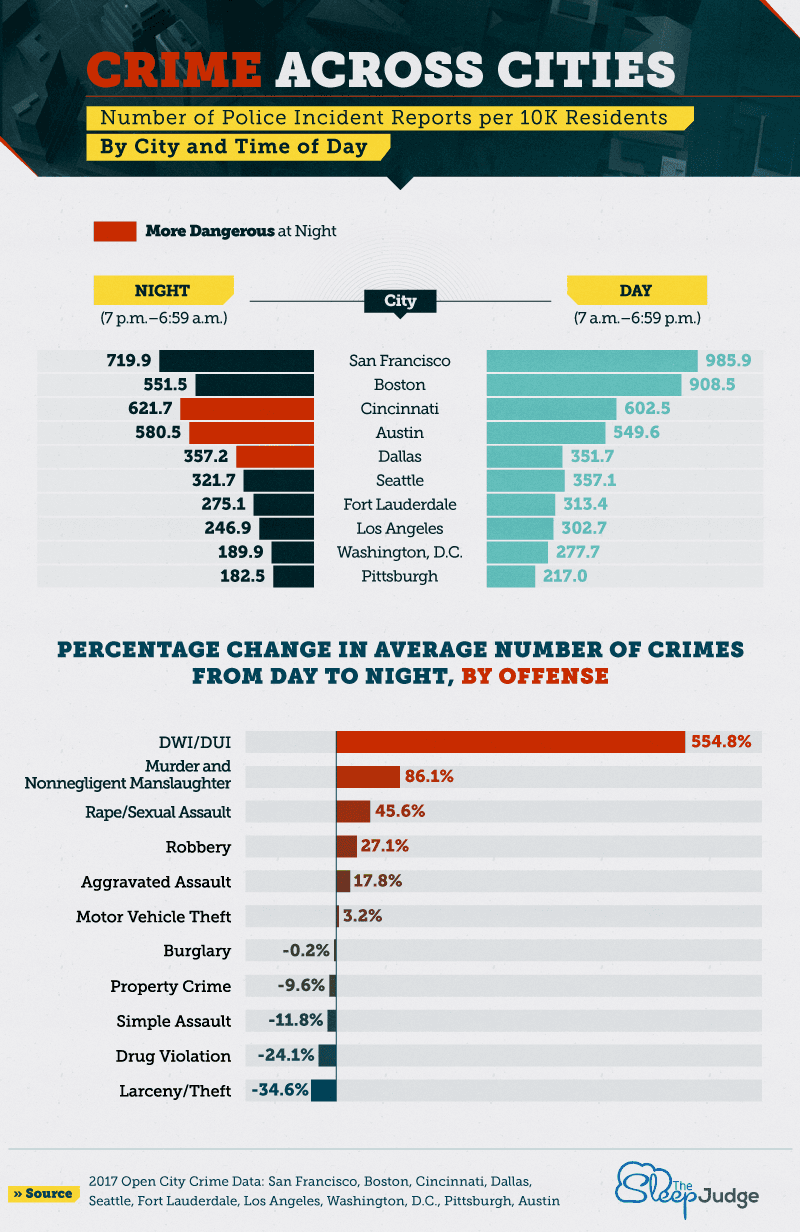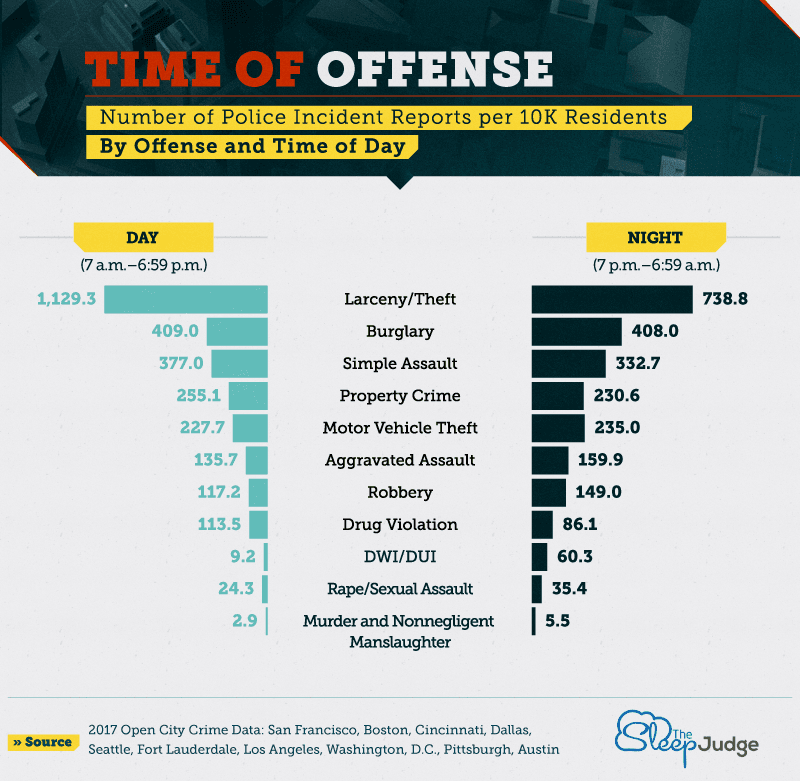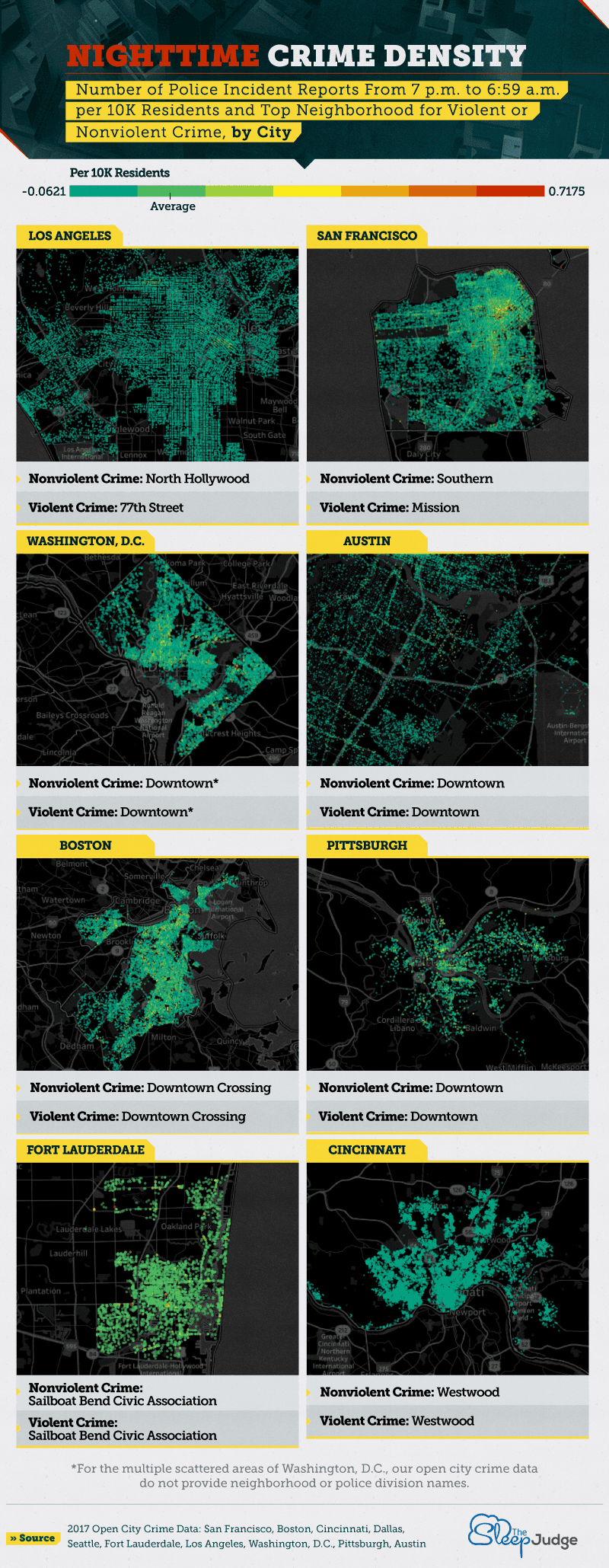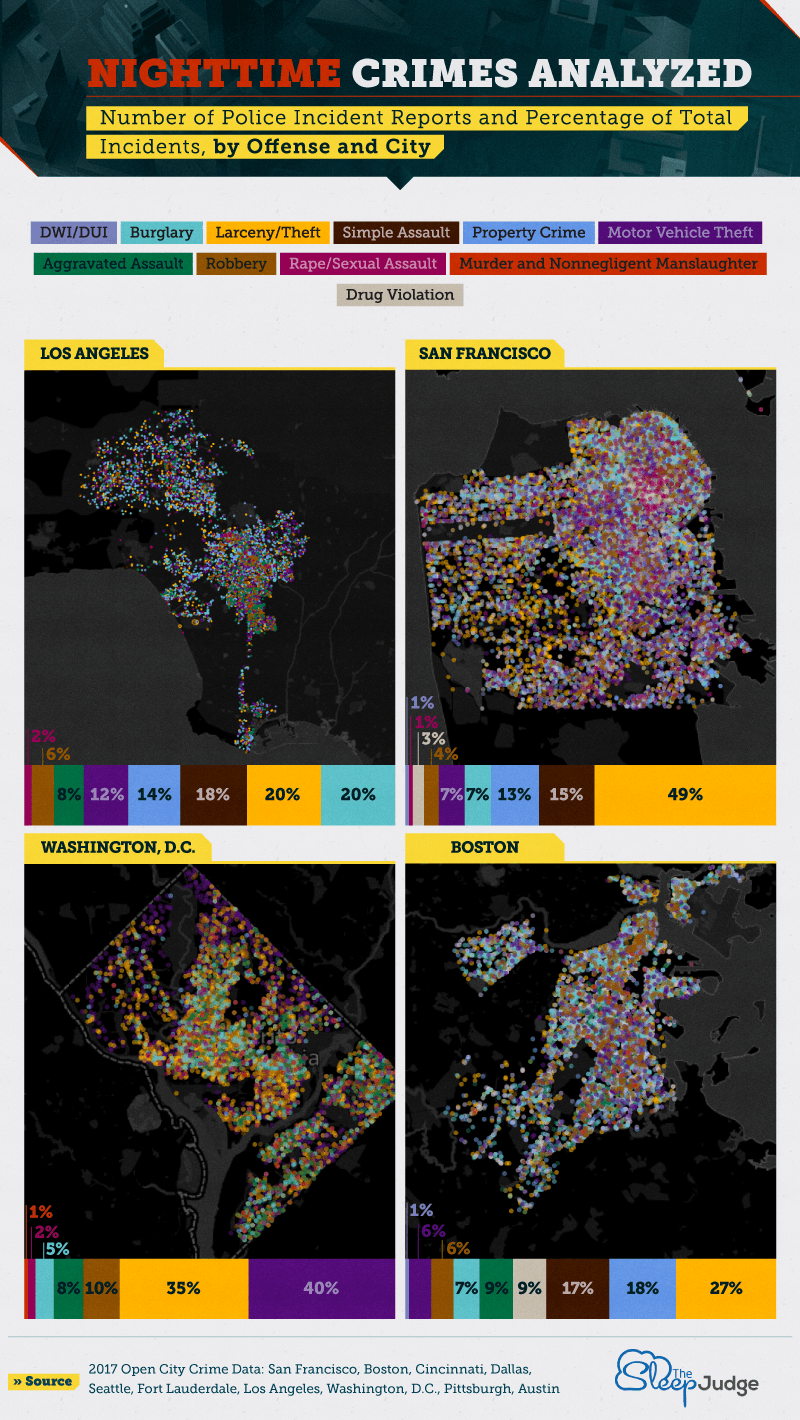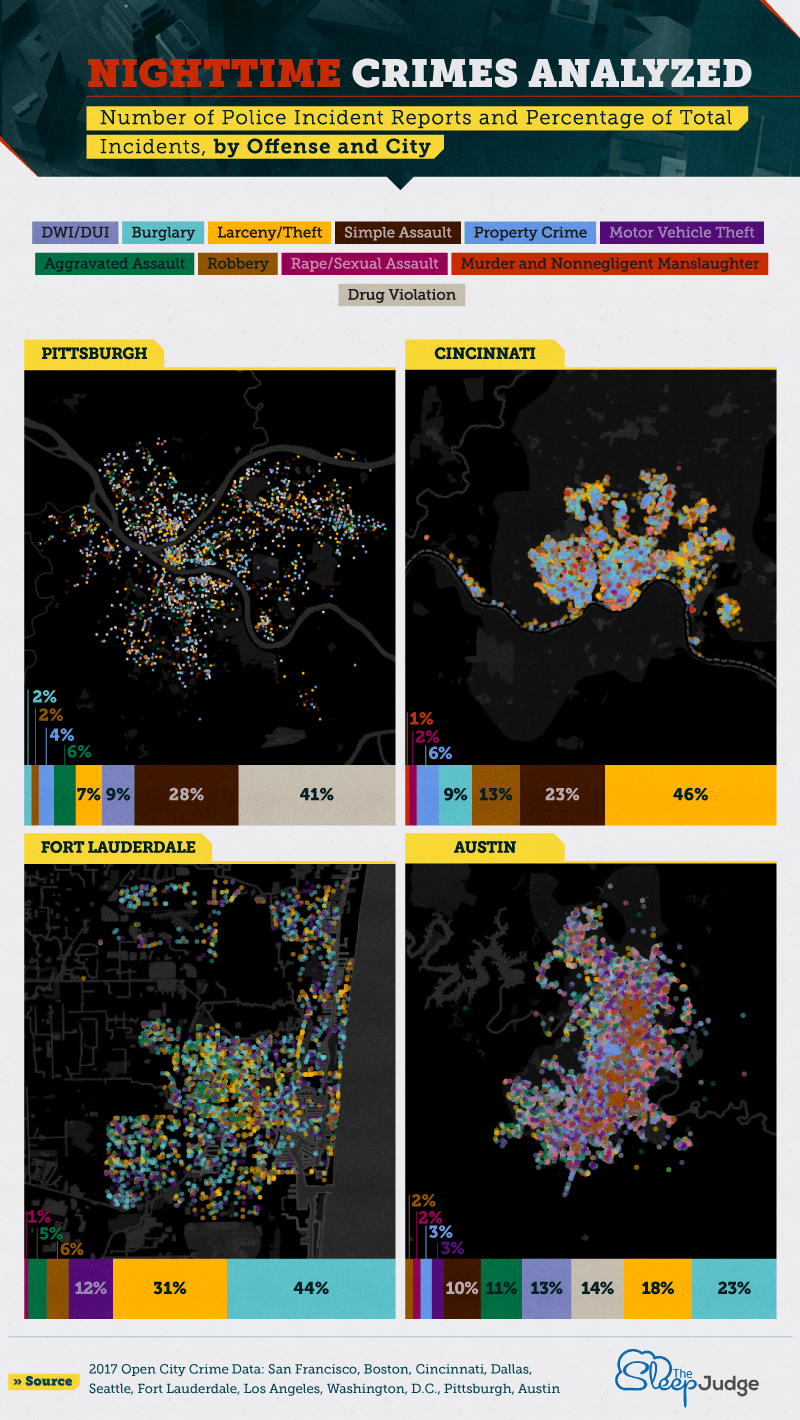Cautious parents often tell their kids that “nothing good happens after midnight” and certainly for good reason. The FBI estimates that 1,247,321 violent crimes occurred in the United States, and it’s no secret that some criminals find their best opportunities in the dark. But which crimes do we actually need to be more aware of during the evening hours – and what’s really going on at night across the U.S.?
We examined more than 840,000 police incidents from 2017 across 10 major American cities to answer that question. We analyzed the types of crime, their locations in each city, the times they occurred, and the density of incidents reported across major metropolitan areas like Los Angeles, San Francisco, Boston, Austin, and Fort Lauderdale. No doubt, this information concerns all of us – and our safety. Keep reading to learn more about what’s really going on while you sleep and why.
Clocked Calls
The unfortunate truth is that crime occurs all day, every day in the United States. But how safe are we really during the day versus the night? We analyzed reports to police during daylight (7 a.m. to 6:59 p.m.) and at night (7 p.m. to 6:59 a.m.) to find out.
More than half of police incidents took place during the day. Larceny/theft, drug violations, simple assaults, and property crimes were slightly more likely to happen while the sun was out, but more violent crimes such as driving while impaired, murder, rape/sexual assault, and robbery were more frequently reported at night. Eighty-seven percent of DWI cases (often referred to as DUIs) happened between 7 p.m. and 6:59 a.m., along with 65 percent of murder/nonnegligent manslaughter cases, 59 percent of rapes and sexual assaults, and 56 percent of robberies.
Hazardous Hours
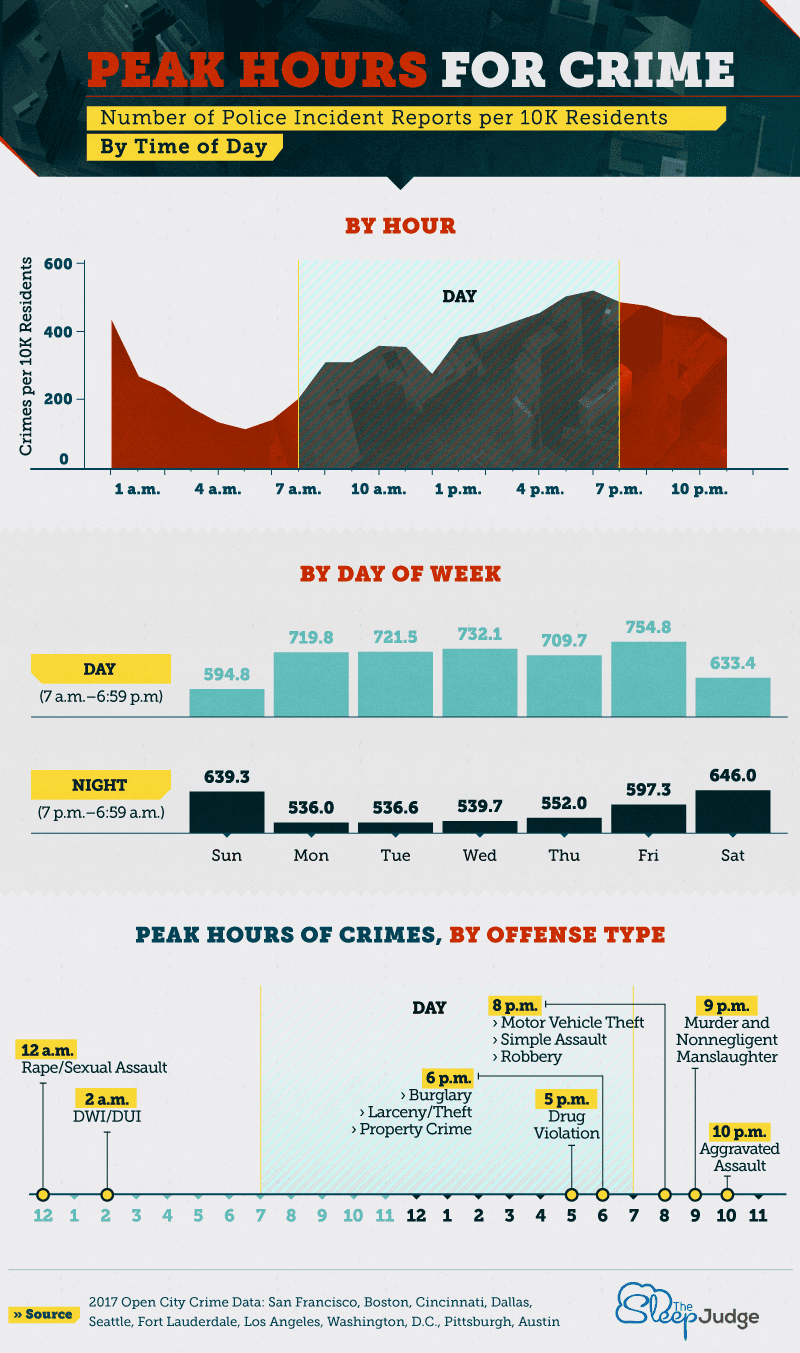
We’ve already established that night hours tend to have the highest rates of violent crime reports. But when are violent crimes most likely to happen? Unfortunately, midnight was the peak hour for violent crimes like rape and sexual assault, while 2 a.m. was the ideal time to stay off the roads – DWI/DUI police incidents happened the most then.
For those looking to stay safe at night, our study shows that murder peaked at 9 p.m. and aggravated assault peaked just an hour after.
City Crimes
As one recent study put it, “Crime is ubiquitous in cities.” High urban density and the relative anonymity that comes with it can give rise to a variety of criminal opportunities. However, our analysis indicates that cities across America vary in the distribution of their crime reports between day and night hours.
For example, 985.9 crimes were reported, on average, during the day in San Francisco, compared to 719.9 crimes at night. For Boston, however, far fewer crime incidents occurred at night – 551.5 on average –while a number similar to San Francisco (908.5) were reported during the day. These two cities, as well as Cincinnati and Austin, stood out as having more crime incidents overall, whereas Pittsburgh, Washington, D.C., and Los Angeles tended to have far fewer crime reports during the day and night
Among these crimes, DWI/DUIs had the highest percentage change from day to night – roughly a 550 percentage change, which translates to around 6 times as many DWI/DUIs at night versus the day. For every 9 DWI/DUIs per 10,000 residents that happen during the day, there are 60 per 10,000 residents that happen at night. When we analyzed data for murder and nonnegligent manslaughter per 10,000 residents, there were three murders during the day compared to five at night. Murder and nonnegligent manslaughter also changed significantly when shifting from day to night, along with rape and sexual assault.
Activity Mapped
Whether it is due to higher rates of crime or a greater police presence, there’s no doubt that certain parts of the city are “known” for police activity and arrests. We used city data from major U.S. metropolitan areas like Boston, Los Angeles, and San Francisco to map where exactly these police incidents are happening. The warmer the color, the higher concentration of police incidents –take a look at how police incidents distribute across your city.
Types of Crime
What parts of your city are most likely to have specific crimes, like burglary, simple assault, motor vehicle theft, or drug violations? We mapped how police incidents were distributed to find out.
The types of incident reports most commonly seen across all cities were larceny/theft, burglary, and simple assault. On the other hand, Washington, D.C., almost appears to be a living grand theft auto – the city had unusually high rates of motor vehicle theft, accounting for 40 percent of police incidents recorded.
Fort Lauderdale had the highest percentage of burglary incidents compared to other major cities, with 44 percent of the police incident reports pertaining to burglary and 31 percent of incidents reporting larceny/theft. Pittsburgh’s crime reporting consisted of numerous drug violations; 41 percent of its total reports were listed as drug-related. It could have something to do with the growing heroin epidemic in Pennsylvania, which recently prompted a disaster declaration by Pennsylvania’s governor.
Safety at Night
Although crime in the U.S. has been on a general decline in recent decades, understanding where and when police incidents happen is, no doubt, important for maximizing the safety of our communities. Our analysis of 840,035 nighttime police incidents across 10 major cities shows there’s a whole world of crime happening while we sleep. However, Americans should rest easy in knowing there’s plenty of data to help researchers and law enforcement study these crimes.
Methodology
We used crime data reported by 10 major cities in the United States to analyze 840,035 police incidents reported during the evening hours in 2017. We designated the hours of 7 p.m. to 6:59 a.m. as “sleeping hours,” as we wanted to capture crime that may potentially take advantage of people being asleep and off-peak hours for work and business. We use the term “crimes” generally, as all records show these are police-reported incidents regardless of whether there was a formal charge. In our project, we created the categorization “Property Crime” from reported incidents of vandalism, arson, and destruction of property. However, sources such as the FBI include larceny, burglary, and motor vehicle theft within their own categorization of “Property Crime.” For our purposes, we wanted to analyze theft separately from the destruction of property. We categorized the police incidents into general crime categories because each city’s labeling varied slightly.
Fair Use Statement
Feel free to share our study with your crew, but do the right thing – give credit where credit is due. Share for noncommercial purposes only, and link back to us to give us credit for our work. Remember, crime doesn’t pay.

